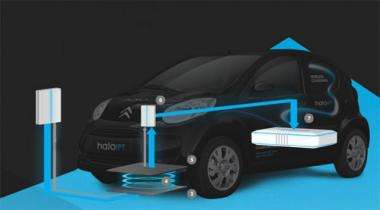Wireless charging system allows the next generation of electric vehicles to be charged wirelessly. Credit: HaloIPT
(PhysOrg.com) -- HaloIPT has recently demonstrated wireless charging of electric vehicles in London using their inductive power transfer technology. The company fitted Citroen electric cars with receiver pads on the underside of the car, allowing the batteries to be charged wirelessly.
Existing electric cars such as the Nissan Leaf and Mitsubishi i-MiEV requires an electric cable to be connected from a socket on the side of the car to street-side power station or electrical socket at home.
The IPT technology uses inductive charging and the electrical pads in the road are buried under the asphalt making them invisible and protecting them from adverse weather conditions. HaloIPT claims that their charging system provides for greater lateral movement which means that the vehicle’s receiving pad does not have to be directly over the transmitter pad.
IPT system allows the next generation of electric vehicles to be charged wirelessly and even powered up as they drive over electrified roads.
IPT System
The primary power supply is powered from the mains supply and energizes a lumped coil; the current ranges anywhere from 5 to125 amps. Since the coil is inductive, compensation may be required using series or parallel capacitors to reduce the working voltages and currents in the supply circuitry.
The receiver pad coils are magnetically coupled to the primary power coil. Power is transferred by tuning the receiver pad coil to the operating frequency of the primary pad coil with series or parallel capacitors. The power transfer is controllable with a switch-mode controller.
The IPT charging system gives drivers a ‘worry free’ solution about forgetting to recharge their electric vehicle. It also eliminates the need for a driver to make a conscious decision about having to charge their vehicle.
According to HaloIPT a commercial scale demo of their IPT technology is expected in 2012.
More information: HaloIPT
© 2010 PhysOrg.com























